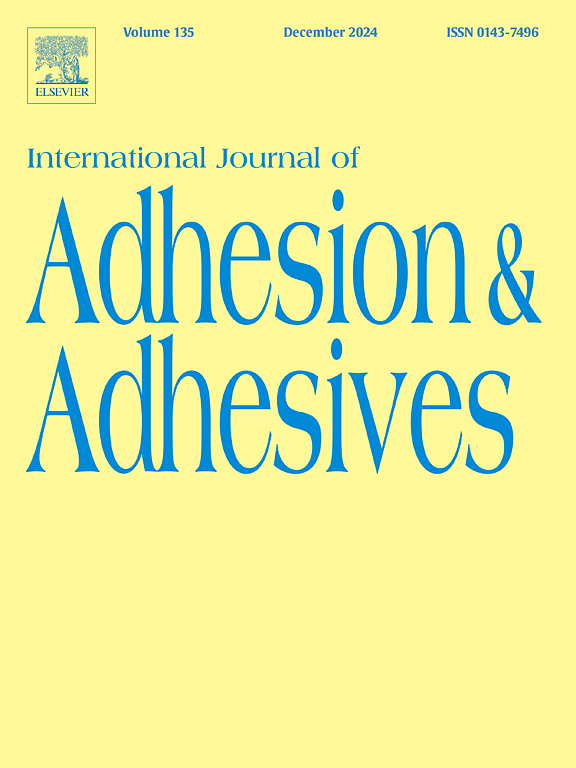亚马逊树种在胶合层压木材生产中的性能
IF 3.5
3区 材料科学
Q2 ENGINEERING, CHEMICAL
International Journal of Adhesion and Adhesives
Pub Date : 2025-07-08
DOI:10.1016/j.ijadhadh.2025.104100
引用次数: 0
摘要
木材由于其可再生的天然特性和高强度,已成为建筑,特别是建筑结构的重要材料。然而,实木在原木尺寸方面有局限性,这使得在需要较大结构部件的建筑中使用实木具有挑战性。在这种情况下,工程木材,如胶合层压木材(胶合木),作为一种创新的解决方案出现。胶合板由几层低密度和中密度的木材与特定的粘合剂粘合而成,这种材料具有优越的机械性能和更大的通用性。本研究分析了4种低密度亚马逊树种(Jacaranda sp., Cedrela fissilis, Cordia goeldiana和Simarouba amara)在不同胶粘剂(PVAc, EPI, PUR和PU)下的性能。进行了抗剪强度和加速分层试验,以评估这些组合在结构应用中的可行性。结果表明,EPI和PU胶粘剂具有优异的抗剪强度,在某些品种中甚至超过了实木的强度。然而,不同物种的表现各不相同,黄貂草与PU的相容性较低。脱层试验表明,EPI和PVAc胶粘剂在外部条件下更有效,而PUR表现出更高的脱层倾向。结论是,只要为每种树种选择合适的粘合剂,所研究的亚马逊树种具有显著的胶合木生产潜力。这不仅促进了亚马逊森林的可持续利用,而且通过增加森林产品的价值和促进环境保护,加强了区域生物经济的发展。本文章由计算机程序翻译,如有差异,请以英文原文为准。
Performance of amazonian species in the production of glued laminated timber
Wood has become an important material in construction, particularly for building structures, due to its renewable natural properties and high strength. However, solid wood has limitations in terms of log dimensions, making it challenging to use in constructions requiring larger structural components. In this context, engineered wood, such as Glued Laminated Timber (glulam), emerges as an innovative solution. Glulam consists of layers of low and medium-density wood bonded with specific adhesives, resulting in a material with superior mechanical properties and greater versatility. This study analyzed the performance of four low-density Amazonian species (Jacaranda sp., Cedrela fissilis, Cordia goeldiana, and Simarouba amara) in combination with different adhesive types (PVAc, EPI, PUR, and PU). Shear strength and accelerated delamination tests were conducted to evaluate the feasibility of these combinations for structural applications. The results indicated that EPI and PU adhesives excelled in shear strength, even surpassing the strength of solid wood in some species. However, performance varied by species, with Cordia goeldiana showing lower compatibility with PU. Delamination tests revealed that EPI and PVAc adhesives were more effective under external conditions, while PUR showed a higher tendency for delamination. It is concluded that the studied Amazonian species have significant potential for glulam production, provided that the appropriate adhesive is selected for each species. This not only promotes the sustainable use of Amazonian forests but also enhances regional bioeconomy development by adding value to forest products and contributing to environmental conservation.
求助全文
通过发布文献求助,成功后即可免费获取论文全文。
去求助
来源期刊

International Journal of Adhesion and Adhesives
工程技术-材料科学:综合
CiteScore
6.90
自引率
8.80%
发文量
200
审稿时长
8.3 months
期刊介绍:
The International Journal of Adhesion and Adhesives draws together the many aspects of the science and technology of adhesive materials, from fundamental research and development work to industrial applications. Subject areas covered include: interfacial interactions, surface chemistry, methods of testing, accumulation of test data on physical and mechanical properties, environmental effects, new adhesive materials, sealants, design of bonded joints, and manufacturing technology.
 求助内容:
求助内容: 应助结果提醒方式:
应助结果提醒方式:


